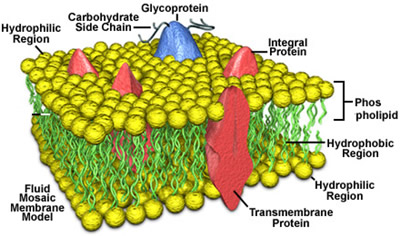Agriculture
All cells, whether prokaryotic or eukaryotic, are surrounded by a membrane called the plasma membrane, an essential barrier between the external environment and the cytoplasm inside the cell. In addition, eukaryotic cells contain other membranes that are part of a variety of organelles, such as nuclei, plastids, mitochondria, vacuoles, Golgi bodies, and the endomembrane system.
Compartmentalization by membranes allows the function of competing processes, such as respiration and photosynthesis, in separate areas of the same cell. In addition, membranes control which molecules enter or leave the cell and the various organelles.
Finally, proteins associated with membranes are responsible for extracellular interactions and the energy transactions involved in photosynthesis and respiration.
Fluid Mosaic Model
In the 1960?s it was believed that all cellular membranes were structured as two outer layers of protein surrounding a lipid layer. In 1972 Jonathan Singer and Garth Nicolson proposed the now-accepted fluid mosaic model.
The lipid component of the membrane forms the basic structure, while the proteins act as enzymes, receptors, and transporters. The lipid molecules, most of which are phospholipids, each have a hydrophilic (?water-loving?) end and a hydrophobic (?water-fearing?) end and associate together such that they form a lipid bilayer.
The hydrophobic ends of the lipids from one layer point toward the hydrophobic ends of the other layer and, by associating only with each other, avoid all contact with water. The hydrophilic ends then form the two water-exposed surfaces.
The major lipids in plant cell membranes are phospholipids (lipids with a phosphorus atom bonded to the hydrophilic end) and sterols. In addition, sugar-containing lipids (glycolipids) and sulfur-containing lipids (sulfolipids) are found to different degrees, depending on the particular membrane. By having different hydrophilic ends, the two surfaces can have a different chemical composition and, therefore, different membrane properties.
Proteins are associated with membranes in one of two ways. Those that are loosely bound to the surface are called peripheral proteins, while those tightly bound to the interior through hydrophobic interactions are referred to as integral proteins. Integral proteins may also have large hydrophilic portions extending from the surface on either orboth sides of the membrane.
Some of the membrane-associated proteins are able to diffuse sideways within the plane of the membrane, giving the membrane a certain fluidity. Membrane proteins with sugar groups attached to the hydrophilic ends are termed glycoproteins and are very common on the membrane surface facing the outside of the cell.
Membrane Properties
The lipid and protein makeup of membranes provides them with several important properties. Due to the hydrophobic nature of the membrane interior, water, some gases, and a few small, noncharged molecules are the only compounds that can cross freely. All other molecules need the help of a transport protein.
Membranes have a high electrical resistance and therefore are capable of maintaining a difference in voltage (called a membrane potential) from one surface to the other. Membrane potentials are used to drive the transport of charged ions and are also involved in sensing of the environment.
In addition, membranes have a low surface tension (that is, they are very ?wettable?) and a net negative surface charge, so they are capable of binding a variety of water-soluble minerals, ions, and proteins (such as the peripheral proteins).
Transport Across Membranes
Large, hydrophilic, or electrically charged solutes cannot pass directly through a cell membrane, yet plants need to be able to move a variety of molecules among the various organelles in the cell.
Therefore, the transport of these solute molecules across membranes is made possible by specific integral, membrane-associated proteins called transport proteins, of which there are two basic types: channel proteins (usually just called channels) and carrier proteins (also called carriers, transporters, or porters).
Several channel proteins together form a pore through the membrane that is filled with water and lined with electrical charges. The size of the pore and the types and number of charges inside it make each individual channel specific for a particular water-soluble ion.
Because the charged solutes merely diffuse through the channel in response to a concentration gradient, no metabolic energy is expended during this type of transport, which is therefore called passive transport.
For carrier proteins, the solute to be transported binds to a portion of the carrier protein, which induces a change in its shape, and that causes the solute to be moved to the other side of the membrane, where it is released.
The carrier protein assumes its previous shape and is then available to bind and transport another solute molecule. Frequently, energy (in the form of adenosine triphosphate, or ATP) is consumed during the operation of carrier proteins in what is known as active transport.
- Active Transport
Active transport is the process by which cells expend energy to move atoms or molecules across membranes, requiring the presence of a protein carrier, which is activated by ATP. Cotransport is active transport that uses a carrier that must simultaneously...
- Cells And Diffusion
Cells and DiffusionPlant cells, like all other living cells, are surrounded by a semipermeable membrane, and any particle moving into or out of the cell must cross this membrane. There are three basic processes by which particles move across plant cell...
- Eukaryotic Cells
Eukaryotic cells (as opposed to prokaryotic cells) have internal, membrane-bound organelles and a distinct nucleus that physically separates the genetic material of the cell from the all of the other parts of the cell. All protists, fungi, plants, and...
- Osmosis, Simple Diffusion, And Facilitated Diffusion
Osmosis, Simple Diffusion, and Facilitated DiffusionOsmosis, simple diffusion, and facilitated diffusion are the processes by which water and other substances?usually small molecules and ions?cross cell membranes. Transport of materials across cellular...
- Root Uptake System
Root Uptake SystemRoot uptake systems are processes by which root cells transport water and nutrients from the soil, across the root surface, and to the tissues that will move the water and nutrients throughout the plant. Fertile soil is a complex mixture...
Agriculture
Membrane Structure
 |
| Membrane Structure |
All cells, whether prokaryotic or eukaryotic, are surrounded by a membrane called the plasma membrane, an essential barrier between the external environment and the cytoplasm inside the cell. In addition, eukaryotic cells contain other membranes that are part of a variety of organelles, such as nuclei, plastids, mitochondria, vacuoles, Golgi bodies, and the endomembrane system.
Compartmentalization by membranes allows the function of competing processes, such as respiration and photosynthesis, in separate areas of the same cell. In addition, membranes control which molecules enter or leave the cell and the various organelles.
Finally, proteins associated with membranes are responsible for extracellular interactions and the energy transactions involved in photosynthesis and respiration.
Fluid Mosaic Model
In the 1960?s it was believed that all cellular membranes were structured as two outer layers of protein surrounding a lipid layer. In 1972 Jonathan Singer and Garth Nicolson proposed the now-accepted fluid mosaic model.
 |
 |
The lipid component of the membrane forms the basic structure, while the proteins act as enzymes, receptors, and transporters. The lipid molecules, most of which are phospholipids, each have a hydrophilic (?water-loving?) end and a hydrophobic (?water-fearing?) end and associate together such that they form a lipid bilayer.
The hydrophobic ends of the lipids from one layer point toward the hydrophobic ends of the other layer and, by associating only with each other, avoid all contact with water. The hydrophilic ends then form the two water-exposed surfaces.
The major lipids in plant cell membranes are phospholipids (lipids with a phosphorus atom bonded to the hydrophilic end) and sterols. In addition, sugar-containing lipids (glycolipids) and sulfur-containing lipids (sulfolipids) are found to different degrees, depending on the particular membrane. By having different hydrophilic ends, the two surfaces can have a different chemical composition and, therefore, different membrane properties.
Proteins are associated with membranes in one of two ways. Those that are loosely bound to the surface are called peripheral proteins, while those tightly bound to the interior through hydrophobic interactions are referred to as integral proteins. Integral proteins may also have large hydrophilic portions extending from the surface on either orboth sides of the membrane.
Some of the membrane-associated proteins are able to diffuse sideways within the plane of the membrane, giving the membrane a certain fluidity. Membrane proteins with sugar groups attached to the hydrophilic ends are termed glycoproteins and are very common on the membrane surface facing the outside of the cell.
Membrane Properties
 |
| Pharmacy in vegetables |
Membranes have a high electrical resistance and therefore are capable of maintaining a difference in voltage (called a membrane potential) from one surface to the other. Membrane potentials are used to drive the transport of charged ions and are also involved in sensing of the environment.
In addition, membranes have a low surface tension (that is, they are very ?wettable?) and a net negative surface charge, so they are capable of binding a variety of water-soluble minerals, ions, and proteins (such as the peripheral proteins).
Transport Across Membranes
Large, hydrophilic, or electrically charged solutes cannot pass directly through a cell membrane, yet plants need to be able to move a variety of molecules among the various organelles in the cell.
Therefore, the transport of these solute molecules across membranes is made possible by specific integral, membrane-associated proteins called transport proteins, of which there are two basic types: channel proteins (usually just called channels) and carrier proteins (also called carriers, transporters, or porters).
Several channel proteins together form a pore through the membrane that is filled with water and lined with electrical charges. The size of the pore and the types and number of charges inside it make each individual channel specific for a particular water-soluble ion.
Because the charged solutes merely diffuse through the channel in response to a concentration gradient, no metabolic energy is expended during this type of transport, which is therefore called passive transport.
For carrier proteins, the solute to be transported binds to a portion of the carrier protein, which induces a change in its shape, and that causes the solute to be moved to the other side of the membrane, where it is released.
The carrier protein assumes its previous shape and is then available to bind and transport another solute molecule. Frequently, energy (in the form of adenosine triphosphate, or ATP) is consumed during the operation of carrier proteins in what is known as active transport.
- Active Transport
Active transport is the process by which cells expend energy to move atoms or molecules across membranes, requiring the presence of a protein carrier, which is activated by ATP. Cotransport is active transport that uses a carrier that must simultaneously...
- Cells And Diffusion
Cells and DiffusionPlant cells, like all other living cells, are surrounded by a semipermeable membrane, and any particle moving into or out of the cell must cross this membrane. There are three basic processes by which particles move across plant cell...
- Eukaryotic Cells
Eukaryotic cells (as opposed to prokaryotic cells) have internal, membrane-bound organelles and a distinct nucleus that physically separates the genetic material of the cell from the all of the other parts of the cell. All protists, fungi, plants, and...
- Osmosis, Simple Diffusion, And Facilitated Diffusion
Osmosis, Simple Diffusion, and Facilitated DiffusionOsmosis, simple diffusion, and facilitated diffusion are the processes by which water and other substances?usually small molecules and ions?cross cell membranes. Transport of materials across cellular...
- Root Uptake System
Root Uptake SystemRoot uptake systems are processes by which root cells transport water and nutrients from the soil, across the root surface, and to the tissues that will move the water and nutrients throughout the plant. Fertile soil is a complex mixture...


